Oyster Biology & Ecology
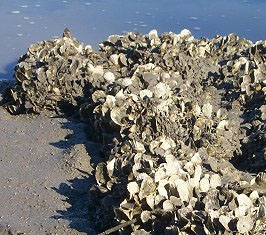
Scientific Name: Crassostrea virginica
Common Names: Eastern oyster, American oyster
Classification:
Kingdom Animalia
Phylum Mollusca
Class Pelecypoda or Bivalvia
Order Lamellibranchia
Family Filibranchia
Genus Crassostrea
species virginica
Range and Habitat
The American or eastern oyster is found along the Atlantic and Gulf of Mexico coasts of North America. Oysters form reefs, which are a dominant feature of many coastal estuaries. Oysters are often considered a "keystone species," providing valuable shelter and habitat for many other estuarine organisms, improving water quality, and reducing bank erosion.
Oysters are typically found in estuaries, sounds, bays, and tidal creeks from brackish water (5 parts per thousand [ppt] salinity) to full strength seawater (35 ppt salinity). Oysters are tolerant organisms, able to withstand wide variations in temperature, salinity, and concentrations of suspended sediments and dissolved oxygen. Throughout much of its range, the oyster occurs mostly in subtidal areas. But in South Carolina, almost all oysters live in the intertidal zone. Intertidal oysters typically have elongated, irregularly shaped shells. When submerged by the tide, oysters feed by filtering phytoplankton (microscopic plants) from the water column.
Explore the image below to identify and learn about organisms commonly found in South Carolina estuaries, a typical environment for oysters.
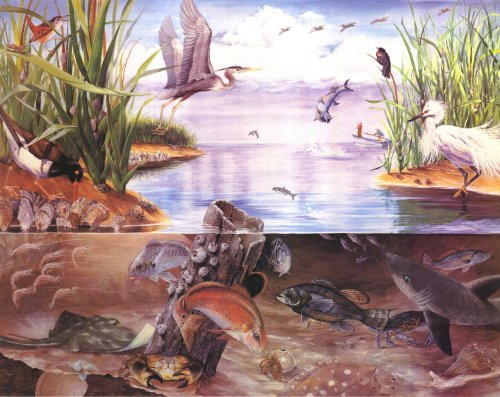
Life Cycle
Adult oysters begin reproduction when water temperatures become greater than 68F (~20C). In South Carolina this generally occurs from May through October. Oysters are broadcast spawners, meaning they release eggs and sperm into the water column. A fertilized egg develops into a planktonic (free-swimming) trochophore larva in about 6 hours. A fully shelled veliger larva is formed within 12 to 24 hours. The larva remains planktonic for about three weeks. Towards the end of this period it develops a foot (hence, pediveliger) and settles to the bottom of the water column where it seeks a hard substrate. When a suitable surface (ideally adult oyster shell) is located, the larva cements itself and metamorphoses to the adult form. This newly attached oyster is known as a "spat."
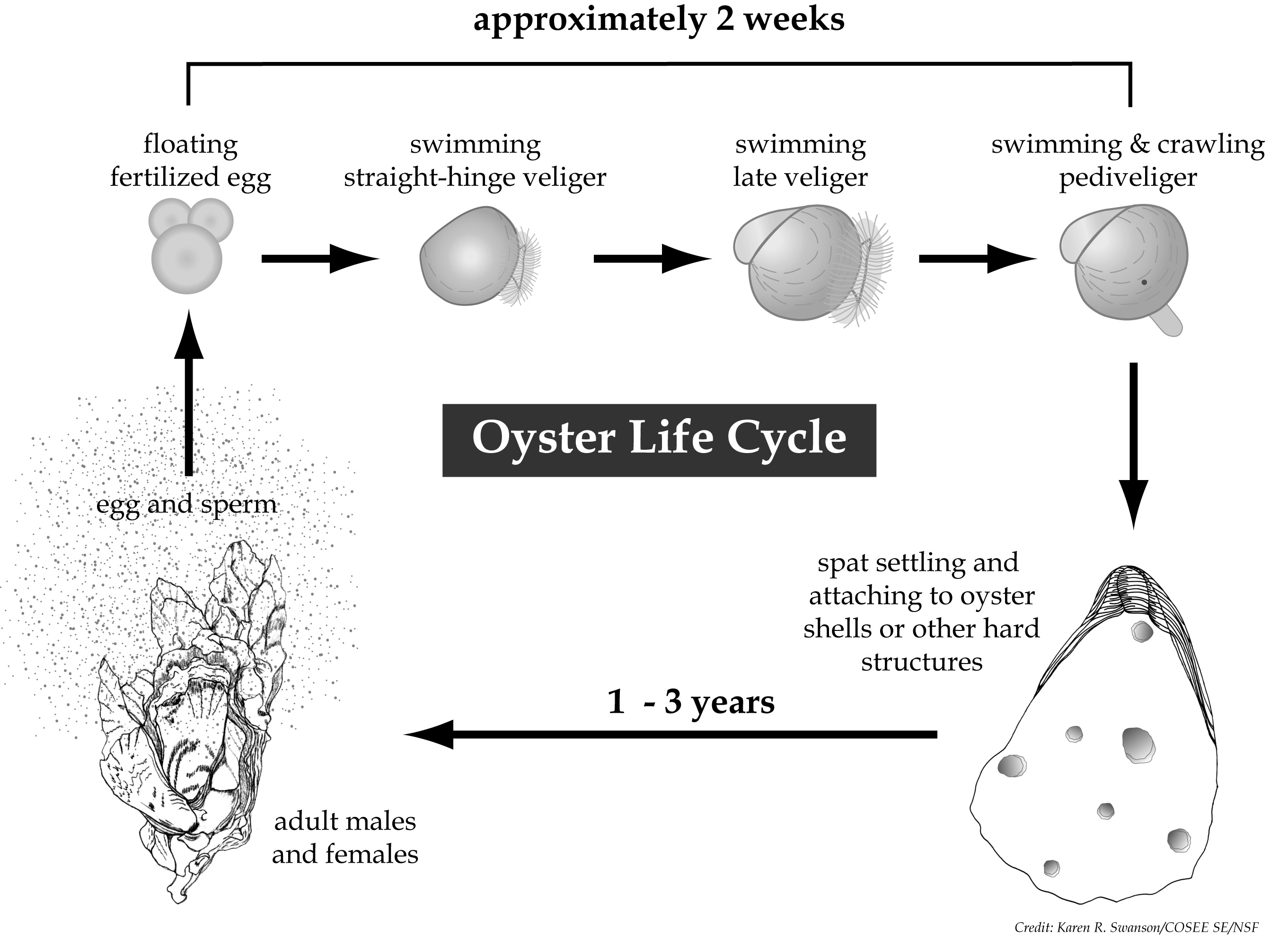
Reef Ecology
Oysters are the building blocks of one of the most important benthic communities in South Carolina estuaries, the oyster reef. Formed as a result of years of oyster production and settlement in concentrated areas, reefs have become home to a complex assemblage of animals and plants. Benefits of oyster reefs to the coastal environment include the following:
- Providing solid structure within the water column for sessile (permanently attached or fixed) organisms (for example, barnacles and sea anemones)
- Creating homes and hiding places for organisms seeking refuge from predation (for example, polychaete worms and soft-shell blue crabs)
- Providing spawning substrate for fishes (for example, gobies, blennies, and skilletfish)
- Stabilizing bottom sediments for benthic organisms (for example, hard clams) and aquatic plants
- Concentrating prey (food) species for larger predator fishes (for example, striped bass)
- Serving as breakwaters to protect adjacent shorelines from erosion
- Filtration and clarification of water
Some of the information in this section is modified from Oysters in the Environment found at www.mdsg.umd.edu.
Species Information
American Oystercatcher
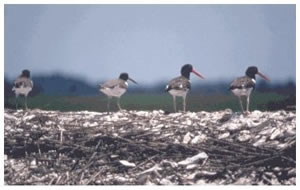
The American oystercatcher (Haematopus palliatus) is named for its habit of feeding on osyters.
The American oystercatcher, once faced with the threat of extinction, is common in South Carolina estuaries (where rivers meet the sea). South Carolina is home to year-round populations, as well as one of the largest wintering populations on the U.S. Atlantic coast. The American oystercatcher nests on sandy beaches, shell mounds, and marsh islands. Its diet consists mainly of oysters and small clams, but it also feeds on snails, barnacles, fiddler crabs, worms, and aquatic insects.
Atlantic Croaker
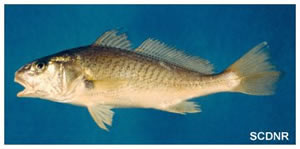
The Atlantic croaker (Micropogonias undulatus) is common in South Carolina estuaries in the spring and summer.
The Atlantic croaker is common in South Carolina estuaries (where rivers meet the sea) in the spring and summer. During this time, juveniles are often found in the flooded salt marsh—where they find food and refuge—while adults are often found in deep tidal creeks. The Atlantic croaker feeds on worms, crustaceans, and smaller fish, and is eaten by various larger fish. The Atlantic croaker is harvested recreationally in South Carolina.
Eastern Oyster

The eastern oyster (Crassostrea virginica), also known as the American oyster, is an economically and ecologically important species found in South Carolina estuaries.
The eastern oyster, also known as the American oyster, is common in South Carolina estuaries (where rivers meet the sea). This bivalve forms reefs and is considered a "keystone species", providing valuable shelter and habitat for many other estuarine organisms, improving water quality, and protecting adjacent shorelines from erosion. The eastern oyster feeds mainly on phytoplankton (microscopic plants), which it filters from the water. It is eaten by various crabs, birds, and fish. The eastern oyster is harvested commercially and recreationally in South Carolina.
Acorn Barnacle
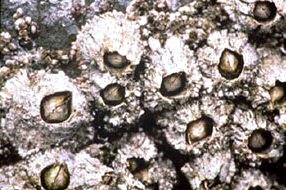
The adult acorn barnacle (Balanus spp.) often lives in dense colonies attached to rocks, pilings, and other hard surfaces. (Photo courtesy of Nancy Sefton)
The acorn barnacle is common in South Carolina estuaries (where rivers meet the sea). As an adult, this crustacean often lives in dense colonies attached to rocks, pilings, and other hard surfaces. The acorn barnacle gets its name from the acorn shape that is formed by the hard calcerous (containing calcium) plates protecting its soft body. Like all barnacles, the acorn barnacle feeds on microscopic plants and animals, which it filters out of the water. Acorn barnacles are eaten by snails, birds, fish, and crabs.
Red-winged Blackbird
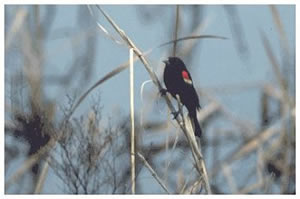
The red-winged blackbird (Agelaius phoeniceus) is named after the adult male of the species, which has a bright red shoulder patch against a glossy black plumage.
The red-winged blackbird resides year-round in South Carolina and is often found in marshes and open fields. This small perching bird is named after the adult male of the species, which has a bright red shoulder patch against a glossy black plumage. The female and her young, on the other hand, are less ornate having dusky brown stripes against a dark brown plumage. Pairs of red-winged blackbirds typically raise two to three broods (young hatched at one time) during the breeding season, which extends from April to June in South Carolina. Nests are constructed by the female using marsh grass, rushes, and sedges, and are typically attached to growing marsh vegetation. The red-winged blackbird feeds on various seeds, grasses, and insects.
Blue Crab

The blue crab (Callinectes sapidus ) is often located within the crevices of oyster reefs, where it finds food and refuge.
The blue crab is common in South Carolina estuaries (where rivers meet the sea). This crustacean is often located within the crevices of oyster reefs, where it finds food and refuge. The blue crab feeds on oysters, clams, snails, shrimp, worms, fish, and other crabs. It is eaten by various fish and birds. The blue crab is harvested commercially and recreationally in South Carolina.
Bottlenosed Dolphin

The bottlenosed dolphin (Tursiops truncatus) is common in South Carolina estuaries and open waters.
The bottlenosed dolphin, named for its blunt snout, is common in South Carolina estuaries (where rivers meet the sea) and open waters. This distinctly social mammal is often observed in groups of four or five. The bottlenosed dolphin feeds on shrimp, crabs, squid, and fish, using a variety of techniques–from capturing single prey individually to capturing multiple prey through coordinated efforts with other dolphins.
Snowy Egret
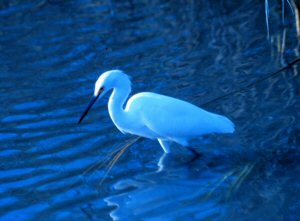
The snowy egret (Egretta thula) is often found wading in shallow estuarine water in search of prey.
The snowy egret, named for its bright white plumage, is a year-round resident in South Carolina. This wading bird is commonly mistaken for its cousin, the great egret (Casmerodius albus). The two can be distinguished by their difference in size and coloration of their bill; the snowy egret is half the size of its cousin and has a black bill, whereas the great egret has a yellow bill. The snowy egret is often found wading in shallow estuarine water (where rivers meet the sea) in search of prey. It feeds mainly on shrimp and fish, particularly mummichogs, mullet, and menhaden.
Atlantic Marsh Fiddler
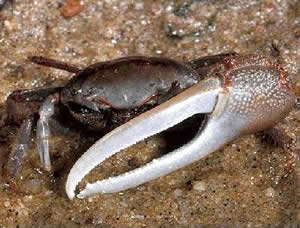
Like all male fiddler crabs, the left claw of a male Atlantic marsh fiddler (Uca pugnax) is much larger than the right claw.
The Atlantic marsh fiddler, also known as a mud fiddler, is common in South Carolina estuaries (where rivers meet the sea). This crustacean thrives in marsh habitats where the substrate is stable enough to allow for the construction of burrows. The Atlantic marsh fiddler is often found foraging for food in large groups along creek banks during low tide. It feeds primarily on algae and decaying plant and animal material, called detritus, and is eaten by various fish, birds, and other crabs.
Southern Flounder
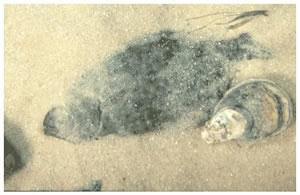
The southern flounder (Paralichthys lethostigma) is often found in shallow water near oyster reefs, where it feeds on grass shrimp and small fish.
The southern flounder is common in South Carolina estuaries (where rivers meet the sea). This bottom-dwelling fish often covers its flattened body with sediment and changes coloration to blend in with its surroundings. This provides protection from predators and enables it to catch prey more easily. The southern flounder is often found in shallow water near oyster reefs, where it feeds on grass shrimp and smaller fish. The southern flounder is harvested commercially and recreationally in South Carolina.
Hard Clam
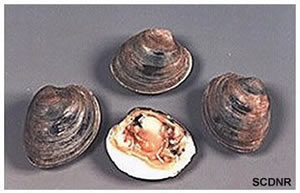
The hard clam (Mercenaria mercenaria) often occurs in dense groups, but does not form reefs like its cousin the oyster.
The hard clam, also known as the northern quahog, is common in South Carolina estuaries (where rivers meet the sea). This bivalve is often located on muddy bottoms in waters as deep as 45 feet. It moves through the mud using a muscular foot. The hard clam often occurs in dense groups, but does not form reefs like its cousin the oyster. The hard clam feeds mainly on phytoplankton (microscopic plants), which it filters from the water. It is eaten by various crabs, birds, and fish. The hard clam is harvested commercially and recreationally in South Carolina.
Longwrist Hermit Crab
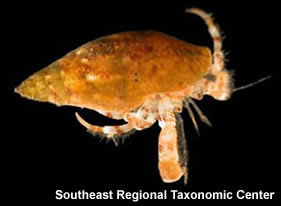
The longwrist hermit crab (Pagurus longicarpus) is often located within the crevices of oyster reefs.
The longwrist hermit crab is common in South Carolina estuaries (where rivers meet the sea) and is often located within the crevices of oyster reefs. The longwrist hermit crab is unlike fiddler crabs and other "true" crabs because its abdomen lacks a protective exo-(outer)skeleton. To protect its soft posterior, the longwrist hermit crab uses the shell of a deceased snail, such as a marsh periwinkle (Littorina irrorata). As the crab grows, it looks for larger shells to occupy. The longwrist hermit crab feeds mainly on decaying plant and animal material, called detritus, and is eaten by various fish, birds, and crabs.
Great Blue Heron
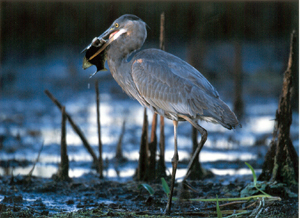
The great blue heron (Ardea herodias) is often found wading in shallow estuarine water in search of prey.
The great blue heron is a year-round resident in South Carolina. This wading bird is appropriately named for its blue-gray plumage and large size and is the largest heron found in North America. The great blue heron is often found wading in shallow estuarine water (where rivers meet the sea) in search of prey. It feeds mainly on shrimp and fish, particularly mummichogs, mullet, and menhaden.
Humans

Humans (Homo sapiens) often fish in estuaries for sport and food. (Photo by Ted Borg)
The human is a terrestrial mammal commonly found in South Carolina estuaries (where rivers meet the sea). This highly social species can be found in groups, often kayaking, canoeing, boating, or fishing. Humans have a varied diet that includes many of the species found in estuaries, including shrimp, crabs, fish, oysters, and clams. Many of these food sources are harvested commercially and recreationally by humans.
Short-Billed Marsh Wren
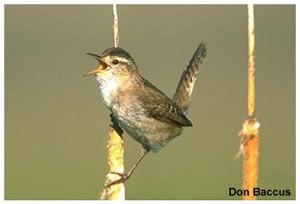
The short-billed marsh wren (Cistothorus platensis) is found in South Carolina marshes during the winter.
The short-billed marsh wren is a winter resident in South Carolina, where it lives in both freshwater marshes and brackish (slightly salty) marshes. This small, perching bird prefers grassy marshes with tall vegetation, which it builds nests in to hide from predators. The short-billed marsh wren feeds mainly on insects and spiders.
Striped Mullet

The striped mullet (Mugil cephalus) is known for its unique habit of jumping up to three feet out of water.
The striped mullet is common in South Carolina estuaries (where rivers meet the sea) and is often found near oyster reefs. As a juvenile, the striped mullet feeds mainly on tiny aquatic animals called zooplankton. As an adult, it feeds mainly on algae and decaying plant matter found in bottom sediments. The striped mullet is eaten by various species including pelicans, spotted seatrout, and dolphins. The striped mullet is harvested commercially and recreationally in South Carolina.
Ribbed-Mussel
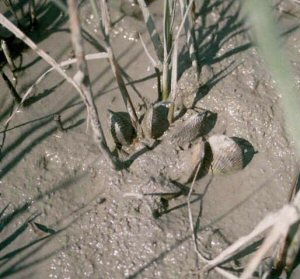
The ribbed-mussel (Geukensia demissa) is one of the more common species of mussel found in South Carolina estuaries. (Photo courtesy of Dale Bishop)
The ribbed-mussel, named for the prominent ribs running the length of its shell, is common in South Carolina estuaries (where rivers meet the sea). This bivalve lives between high and low tide and is often found partially buried in muddy sediment, attached to pilings, or within oyster reefs. Like all mussels, the ribbed-mussel is able to move slowly from place to place using a muscular foot, and can anchor itself using a cluster of thread-like fibers in combination with a glue-like secretion. The ribbed-mussel feeds on plankton (microscopic organisms), which it filters from the water, and is eaten by various birds, crabs, and fish. The ribbed-mussel is harvested recreationally in South Carolina.
Eastern Brown Pelican

The eastern brown pelican (Pelecanus occidentalis carolinensis) is the only species of pelican found in South Carolina.
The eastern brown pelican, once listed in South Carolina as an endangered species, is commonly seen flying in flock over the ocean, beaches, and estuaries (where rivers meet the sea). This large marine bird feeds exclusively on fish, and has a unique feeding behavior. It plunge-dives into the water, and while submerged, it uses its expandable throat pouch to take in both water and fish. As the pelican resurfaces, it drains the water from its pouch and then tilts its head upward to swallow the catch.
Red Drum
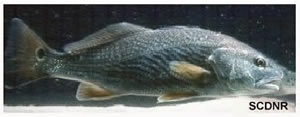
The red drum (Sciaenops ocellatus) is often found near oyster reefs as a juvenile.
The red drum, also called channel bass or spottail bass, is common in South Carolina estuaries (where rivers meet the sea) and offshore areas. Juvenile red drum are often found near oyster reefs in shallow tidal creeks and flooded salt marshes—where they find food and refuge. Juvenile red drum feed on fiddler crabs, mud crabs, grass shrimp, and small fish and are eaten by various larger fish. Adult red drum live in deep estuarine waters and offshore. Recreational harvesting of red drum is allowed in South Carolina, but commercial harvesting is restricted.
Black Sea Bass
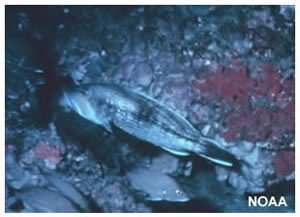
The black sea bass (Centropristis striata) is often found near oyster reefs and other hard submerged structures.
The black sea bass is common in South Carolina estuaries (where rivers meet the sea) and offshore areas. As a juvenile, this fish has a brownish color and lives in estuaries from July to November (juveniles migrate offshore in December). It is often found near hard submerged structures, such as pier pilings and oyster reefs, where it feeds mainly on shrimp and other small crustaceans. As an adult, this fish has a bluish-black color and lives offshore, where it feeds mainly on crabs and small fish. The black sea bass is harvested commercially and recreationally in South Carolina.
Sheepshead
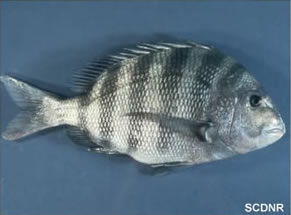
The sheepshead (Archosargus probatocephalus) is often found near oyster reefs and other hard submerged structures.
The sheepshead is common in South Carolina estuaries (where rivers meet the sea) during spring and summer. This fish is often found near oyster reefs and the pilings of piers, docks, and bridges. The sheepshead feeds on barnacles, oysters, mussels, small crabs, and shrimp and is eaten by various larger fish. The sheapshead is harvested recreationally in South Carolina.
Marsh Grass Shrimp
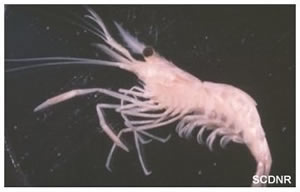
The marsh grass shrimp (Palaemonetes vulgaris) lives in South Carolina salt marshes year-round and is often found on or near oyster reefs.
The marsh grass shrimp is one of several shrimp species found in South Carolina estuaries (where rivers meet the sea). This crustacean lives in the salt marsh year-round and is often found on or near oyster reefs. The marsh grass shrimp feeds mainly on algae and decaying plant and animal material (called detritus) and is eaten by various fish, birds, and crabs. The marsh grass shrimp is not harvested commercially or recreationally in South Carolina.>
Smooth Cordgrass
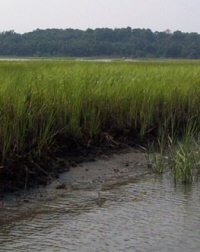
Smooth cordgrass (Spartina alterniflora) is a salt marsh plant, as well as a food source for many organisms.
Smooth cordgrass is a perennial (present year round) wetland grass that dominates the lower part of tidal salt marshes in South Carolina. This abundant salt marsh plant is an integral part of the marsh food web. The seeds of smooth cordgrass are eaten by a number of birds and migratory waterfowl, and the roots are sometimes eaten by wintering geese. The leaves, which die in late fall, decompose into a nutrient-rich food source for many marsh residents, including oysters, shrimps, and crabs.
Southern Stingray

The southern stingray (Dasyatis americana) can reach up to six feet across and is the largest stingray found on the southeastern and Gulf coasts.
The southern stingray is common in South Carolina estuaries (where rivers meet the sea). This bottom-dwelling fish is related to sharks, skates, and other rays, who, unlike bony fish, have skeletons made entirely of cartilage (relatively soft, flexible tissue). Like all stingrays, the southern stingray has a venomous, stinging spine attached to the base of its tail. The southern stingray also has a flattened body, which it often covers with sediment to blend in with its surroundings. This provides protection from predators and enables it to catch prey more easily. The southern stingray feeds on worms, shrimp, crabs, small fish, and bivalves, such as oysters and clams.
Florida Stone Crab
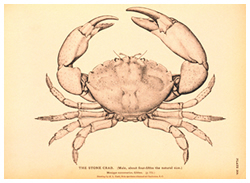
The Florida stone crab (Menippe mercenaria) is often located within the crevices of oyster reefs, where it finds food and refuge.
Contrary to its name, the Florida stone crab is common in South Carolina estuaries (where rivers meet the sea). This crustacean is often located within the crevices of oyster reefs, where it finds food and refuge. The adult Florida stone crab feeds on small invertebrates, such as oysters, barnacles, and snails. It is eaten by large fish, such as sheepshead. In South Carolina, only the larger of the crab's two claws can be harvested. Like most crustaceans, the Florida stone crab can regenerate missing or damaged appendages.
Tarpon
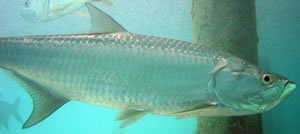
Adult tarpon (Megalops atlanticus) are quite large, typically ranging between four to eight feet in length.
The tarpon is common in South Carolina estuaries (where rivers meet the sea) as an adult. This large fish feeds mainly on shrimp, crabs, and small fish, and is eaten primarily by sharks. Recreational harvesting of tarpon is allowed in South Carolina, but commercial harvesting is restricted.
Spotted Seatrout
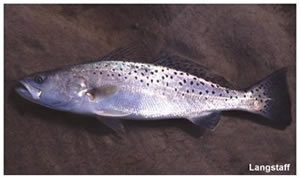
The spotted seatrout (Cynoscion nebulosus) is often found feeding in shallow tidal creeks near flooded salt marshes.
The spotted seatrout is common year-round in South Carolina estuaries (where rivers meet the sea). Contrary to its name, the spotted seatrout is not a member of the trout family (Salmonidae), but of the drum family (Sciaenidae). Like all members of the drum family, mature males produce a "drumming" sound to attract females during the spawning season (May through early September). This fish is often found in shallow tidal creeks near flooded salt marshes, where it feeds mainly on grass shrimp and small fish. Recreational harvesting of spotted seatrout is allowed in South Carolina, but commercial harvesting is restricted.
Knobbed Whelk
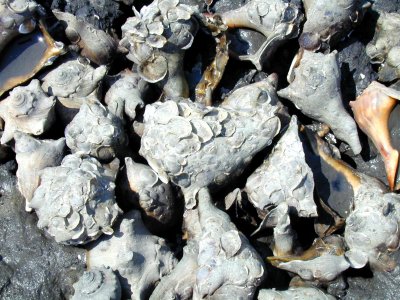
The empty shell of a knobbed whelk (Busycon carica) is sometimes used by oyster larva (free-swimming young) as hard substrate to permanently settle on. (Photo courtesy of Sara K. Saksewski)
The knobbed whelk, named for the knob-like projections on the upper, spiral part of its shell, is common in South Carolina estuaries (where rivers meet the sea). This snail lives on sandy and muddy bottoms in waters as deep as 60 feet. It moves through the sand and mud using a muscular foot. The knobbed whelk feeds mainly on bivalves, such as oysters and clams. The knobbed whelk can be harvested commercially or recreationally in South Carolina (albeit with restrictions).
